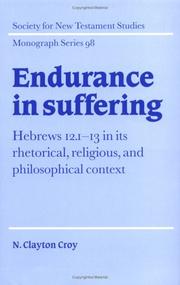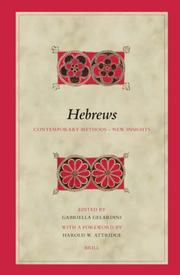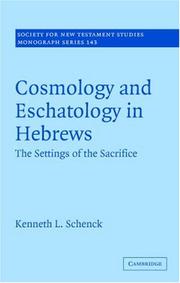| Listing 1 - 8 of 8 |
Sort by
|
Book
ISBN: 9783110426571 3110426579 9783110422597 9783110422764 311042259X 311042276X 9783110422603 3110422603 Year: 2016 Volume: 216 Publisher: Berlin De Gruyter
Abstract | Keywords | Export | Availability | Bookmark
 Loading...
Loading...Choose an application
- Reference Manager
- EndNote
- RefWorks (Direct export to RefWorks)
A cursory glance at Hebrews' critique of Israel's fear at Sinai in Heb 12:18-29 suggests that the author has misunderstood or manipulated his sources. In the Pentateuch, the appointment of Moses as Israel's mediator receives explicit approval (Exod 19:9; Deut 5:28), while Heb 12:25 labels their request for mediation a "refusal" to heed the word of God. This book argues that Hebrews' use of the Sinai narratives resides on a complex trajectory established by four points: the Sinai covenant according to Exodus, the reenactment of that covenant according to Deuteronomy, the call for a NEW covenant according to Jeremiah, and the present reality of that covenant established by God and mediated by Jesus Christ.The basis for Hebrews' critique arises from its insight that while Israel's request established covenant-from-a-distance, Jesus demonstrates that true covenant mediation brings two parties into a single space. The purpose for Hebrews critique lies in its summons to Zion, the mountain on which Jesus sits at the right hand of God as the high priestly mediator of the new covenant.
Fear --- Failure (Psychology) --- 227.1*9 --- 227.1*9 Brief van Paulus aan de Hebreeën --- Brief van Paulus aan de Hebreeën --- Losing (Psychology) --- Psychology --- Fear of failure --- Success --- Fright --- Emotions --- Anxiety --- Horror --- Biblical teaching. --- Bible. --- Criticism, interpretation, etc. --- Christianity --- Religion --- Philosophy & Religion --- Biblical teaching --- Covenants --- Israel (Christian theology) --- Hebrews. --- Moses. --- Sinai. --- Zion. --- RELIGION / Biblical Studies / Paul's Letters.

ISBN: 0521593050 0521018919 0511585292 051100494X 9780521593052 9780511004940 9780511585296 9780521018913 Year: 1998 Volume: 98 Publisher: Cambridge Cambridge University Press
Abstract | Keywords | Export | Availability | Bookmark
 Loading...
Loading...Choose an application
- Reference Manager
- EndNote
- RefWorks (Direct export to RefWorks)
Hebrews 12: 1-13 portrays the suffering of the community to which it is addressed by means of two images: an athletic contest, and God's fatherly discipline. In this 1998 book, N. Clayton Croy provides a thorough exploration of the theme of suffering in the Jewish and Graeco-Roman traditions, and surveys the different interpretations of this passage which have been offered by Christian writers over the centuries. He argues that the concept of 'training' unites the passage, which presents Jesus as the supreme athlete, an agonistic exemplar for those running the race. These verses also support a non-punitive understanding of discipline, in which God's children undergo a positive process of education. The educative notion of paideia combines with images of athletic training to establish a call to faithful endurance rather than repentance.
Bible --- Criticism, interpretation, etc --- 227.1*9 --- 227.1*9 Brief van Paulus aan de Hebreeën --- Brief van Paulus aan de Hebreeën --- Bible. --- Epistle to the Hebrews --- Hebräerbrief (Book of the New Testament) --- Hebrews (Book of the New Testament) --- Poslanie do Evreite (Book of the New Testament) --- Risālah ilá al-ʻIbrānīyīn (Book of the New Testament) --- Criticism, interpretation, etc. --- Arts and Humanities --- Religion

ISBN: 9004144900 9789004144903 9789047407928 904740792X 1433707918 9781433707919 1280868422 9781280868429 9786610868421 Year: 2005 Volume: 75 Publisher: Leiden Brill
Abstract | Keywords | Export | Availability | Bookmark
 Loading...
Loading...Choose an application
- Reference Manager
- EndNote
- RefWorks (Direct export to RefWorks)
The present volume contains a collection of fourteen essays applying the latest and neglected methods and offering new and innovative insights into the interpretation of the New Testament book To the Hebrews. The excitingly diverse contributions, which stem from an intriguing international group of senior and younger Hebrews, New Testament, and Old Testament scholars, are presented in three parts: Part One focuses on cultic language, concepts, and practice in Hebrews; Part Two on sociology, ethics, and rhetoric in Hebrews; and Part Three on textual-historical, comparative, and intertextual approaches to Hebrews. As the first ever compilation of essays on Hebrews by a range of authors, this volume presents an important contribution to the field of New Testament studies. It will particularly appeal to students, teachers, and scholars interested in a variety of critical perspectives on Hebrews and on the New Testament's third great theologian next to Paul and John. Moreover, the treatment of hermeneutical, cultic, sociological, and comparative matters in the context of biblical, Greco-Roman, and rabbinic literature will make this collection valuable to an even broader readership.
227.1*9 --- 227.1*9 Brief van Paulus aan de Hebreeën --- Brief van Paulus aan de Hebreeën --- Bible. --- Epistle to the Hebrews --- Hebräerbrief (Book of the New Testament) --- Hebrews (Book of the New Testament) --- Poslanie do Evreite (Book of the New Testament) --- Risālah ilá al-ʻIbrānīyīn (Book of the New Testament) --- Criticism, interpretation, etc. --- Hebrews (Book of the Bible) --- Bible --- Criticism, interpretation, etc
Book
ISBN: 9783110475814 3110475812 9783110477139 9783110475890 3110477130 3110475898 9783110477146 3110477149 Year: 2016 Volume: 222 Publisher: Berlin De Gruyter
Abstract | Keywords | Export | Availability | Bookmark
 Loading...
Loading...Choose an application
- Reference Manager
- EndNote
- RefWorks (Direct export to RefWorks)
This monograph examines Hebrews’ understanding of the relationship between old covenant sacrifices and Christ’s new covenant sacrifice, especially as it relates to the question of efficacy. Most scholars think the author of Hebrews strips the levitical sacrifices of most, if not all, efficacy, but this work affirms a more positive depiction of the levitical sacrifices. A mystical apocalyptic tradition stands behind Hebrews’ description of the heavenly cult , which establishes the framework for relating the levitical sacrifice to Christ’s sacrifice. The earthly, levitical cult was efficacious when it corresponded to or synchronized with the heavenly sacrifice of Christ. Still, the author of Hebrews develops the notion of the heavenly cult in unique ways, as Christ’s sacrifice both validates the earthly practice but also, due to his new covenant theology, calls for its end. Ribbens’ bold proposal joins a growing number of scholars that place Hebrews in the mystical apocalyptic tradition, highlights positive statements in Hebrews related to the efficacy of levitical sacrifices that are often overlooked, and relies on the heavenly cult to reconcile the positive and negative descriptions of the levitical cult.
Sacrifice --- 227.1*9 --- 227.1*9 Brief van Paulus aan de Hebreeën --- Brief van Paulus aan de Hebreeën --- Biblical teaching. --- Bible. --- Epistle to the Hebrews --- Hebräerbrief (Book of the New Testament) --- Hebrews (Book of the New Testament) --- Poslanie do Evreite (Book of the New Testament) --- Risālah ilá al-ʻIbrānīyīn (Book of the New Testament) --- Criticism, interpretation, etc. --- Bible teaching. --- Burnt offering --- Worship --- Biblical teaching --- Hebrews. --- heavenly sanctuary. --- sacramental type. --- sacrifice.

ISBN: 9780521883238 9780511488177 9780521130479 0511488173 9780511379239 0511379234 1107185807 9781107185807 1281243787 9781281243782 9786611243784 661124378X 0511377487 9780511377488 0511376545 9780511376542 0511375018 9780511375019 0521883237 0521130476 051137836X Year: 2007 Volume: 143 Publisher: Cambridge Cambridge university press
Abstract | Keywords | Export | Availability | Bookmark
 Loading...
Loading...Choose an application
- Reference Manager
- EndNote
- RefWorks (Direct export to RefWorks)
Scholars argue over where Hebrews fit in the first century world. Kenneth L. Schenck works towards resolving this question by approaching Hebrews' cosmology and eschatology from a text-orientated perspective. After observing that the key passages in the background debate mostly relate to the 'settings' of the story of salvation history evoked by Hebrews, Schenck attempts to delineate those settings by asking how the 'rhetorical world' of Hebrews engages that underlying narrative. Hebrews largely argue from an eschatology of two ages, which correspond to two covenants. The fresh age has come despite the continuance of some old age elements. The most characteristic elements of Hebrews' settings, however, are its spatial settings, where we find an underlying metaphysical dualism between the highest heaven, which is the domain of spirit, and the created realm, including the created heavens. This creation will be removed at the eschaton, leaving only the unshakeable heaven.
Biblical cosmology. --- Eschatology --- Cosmologie biblique --- Eschatologie --- Biblical teaching. --- Enseignement biblique --- Bible. --- Criticism, interpretation, etc. --- 227.1*9 --- Cosmology, Biblical --- Cosmology --- Creation --- Brief van Paulus aan de Hebreeën --- Epistle to the Hebrews --- Hebräerbrief (Book of the New Testament) --- Hebrews (Book of the New Testament) --- Poslanie do Evreite (Book of the New Testament) --- Risālah ilá al-ʻIbrānīyīn (Book of the New Testament) --- 227.1*9 Brief van Paulus aan de Hebreeën --- Biblical cosmology --- Biblical teaching --- Arts and Humanities --- Religion --- Eschatology - Biblical teaching.

ISSN: 09280731 ISBN: 9789004154063 900415406X 9786611400699 1281400696 9047411072 9789047411079 9781281400697 6611400699 Year: 2007 Volume: v. 83 Publisher: Leiden ; Brill
Abstract | Keywords | Export | Availability | Bookmark
 Loading...
Loading...Choose an application
- Reference Manager
- EndNote
- RefWorks (Direct export to RefWorks)
This volume offers the first in-depth analysis of the literary structure of Hebrews against the background of its most frequently mentioned Sitz im Leben, the ancient synagogue. In the context of the liturgical year and its reconstructed cycle of readings, the text is newly interpreted on the basis of Exod 31:18–32:35 and Jer 31:31–34, so as to demonstrate that Hebrews was an ancient homily for the most important fast-day, Tisha be-Av, on which the destruction of the two temples was commemorated. The first part presents 20th- and 21st-century scholarship on Hebrews and a new structural analysis. The second part offers a detailed discussion of the ancient synagogue and its liturgy. This allows the reconstruction of the readings on which the text of Hebrews is based and a positioning within the liturgical year. The resulting thesis, that Hebrews is an exhortative homily for Tisha be-Av, is confirmed through a motivic analysis of all the biblical texts read on this fast-day. On the basis of the hermeneutical key thereby established, the third part offers seven cumulative readings of the entire text: structural, contextual, intertextual, rhetorical, theological, socio-historical, and hermeneutical-critical. These generate new interpretations and insights within the horizon of current Hebrews scholarship. The present monograph is the first to connect research on the ancient synagogue and its liturgy with a comprehensive interpretation of Hebrews that also discusses alternative form-critical avenues and establishes intertextual connections, especially to relevant rabbinic texts. The examination is directed not only to those with a specific interest in Hebrews, but also to scholars and students of the New Testament, Theology, Jewish Studies, and Religious Studies. ***** Der vorliegende Band bietet erstmals eine fundierte Analyse der literarischen Struktur des Hebräers vor dem Hintergrund seines meistgenannten Sitzes im Leben, der antiken Synagoge. Im Kontext des liturgischen Jahres sowie des rekonstruierten Lesezyklus’ wird die Schrift neu auf der Basis der Lesungen aus Ex 31,18–32,35 und Jer 31,31–34 als antike Homilie zum wichtigsten Fasttag von Tischa be-Aw, an dem der Zerstörung der beiden Tempel gedacht wurde, erschlossen. Die Untersuchung stellt im ersten Teil die Hebräerforschung des 20. und 21. Jahrhunderts sowie eine neue Strukturanalyse vor. Der zweite Teil fügt eine profunde Untersuchung der antiken Synagoge sowie der antiken Synagogenhomilie im liturgischen Kontext hinzu. Diese erlaubt die Rekonstruktion der dem Hebräertext zugrunde liegenden Lesungen und eine Positionierung innerhalb des liturgischen Jahres. Die resultierende These, dass der Hebräer eine mahnende Homilie zu Tischa be-Aw sei, wird im Rahmen einer Motivanalyse sämtlicher zu diesem Fasttag gelesenen biblischen Texte bekräftigt. Im dritten Teil wird der gesamte Text auf der Basis des etablierten hermeneutischen Schlüssels sieben kumulativen Lesungen unterzogen, einer strukturellen, kontextuellen, intertextuellen, rhetorischen, theologischen, sozio-historischen sowie einer hermeneutisch-kritischen. Diese generieren vor dem Horizont der aktuellen Hebräerforschung neue Interpretationsmöglichkeiten und Einsichten. Die vorliegende Monographie verbindet zum ersten Mal Forschungen zur antiken Synagoge und ihrer Liturgie mit einer kohärenten Interpretation des Hebräertextes, die auch alternative formkritische Ansätze thematisiert sowie intertextuelle Bezüge insbesondere zu relevanten rabbinischen Texten benennt. Die Ausführungen richten sich somit nicht nur an solche mit einem spezifischen Interesse am Hebräer, sondern auch an ForscherInnen und StudentInnen des Neuen Testaments, der Theologie, der Judaistik sowie der Religionswissenschaften.
Synagogues --- Sermons, Greek --- Ninth of Av --- History --- Bible --- Sermons, Greek. --- Av, Ninth of --- Tishʻah be-Av --- Tisha b'Ab --- Tisha b'Av --- Tisha be-Av --- Tishah b'Ab --- Tishah b'Av --- Tishah be'Ab --- Nine Days (Jewish mourning custom) --- Jewish architecture --- Epistle to the Hebrews --- Hebräerbrief (Book of the New Testament) --- Hebrews (Book of the New Testament) --- Poslanie do Evreite (Book of the New Testament) --- Risālah ilá al-ʻIbrānīyīn (Book of the New Testament) --- 227.1*9 --- Religious institutions --- Temples --- Greek sermons --- 227.1*9 Brief van Paulus aan de Hebreeën --- Brief van Paulus aan de Hebreeën --- Fasts and feasts --- Judaism --- Bible. --- Hebreeën (bijbelboek) --- Synagogen. --- Synagogues - History - To 1500 --- Ninth of Av - Sermons
Book
ISBN: 1283161818 9786613161819 9004206914 9789004206915 9789004206519 9004206515 9781283161817 6613161810 Year: 2011 Volume: 141 Publisher: Leiden Boston Brill
Abstract | Keywords | Export | Availability | Bookmark
 Loading...
Loading...Choose an application
- Reference Manager
- EndNote
- RefWorks (Direct export to RefWorks)
Scholars often explain Hebrews’ relative silence regarding Jesus’ resurrection by emphasizing the author’s appeal to Yom Kippur’s two key moments—the sacrificial slaughter and the high priest’s presentation of blood in the holy of holies—in his distinctive portrayal of Jesus’ death and heavenly exaltation. The writer’s depiction of Jesus as the high priest whose blood effected ultimate atonement appears to be modeled upon these two moments. Such a typology discourages discrete reflection on Jesus’ resurrection. Drawing on contemporary studies of Jewish sacrifice (which note that blood represents life, not death), parallels in Jewish apocalyptic literature, and fresh exegetical insights, this volume demonstrates that Jesus’ embodied, resurrected life is crucial for the high-priestly Christology and sacrificial soteriology developed in Hebrews.
Atonement - Bibilical teaching. --- Atonement -- Bibilical teaching. --- Bible. -- N.T. -- Hebrews -- Criticism, interpretation, etc. --- Jesus Christ - Resurrection - Biblical teaching. --- Jesus Christ -- Resurrection -- Biblical teaching. --- Sacrifice - Judaism. --- Sacrifice -- Judaism. --- Atonement --- Sacrifice --- Religion --- Philosophy & Religion --- Christianity --- Bibilical teaching --- Judaism --- Biblical teaching. --- Judaism. --- Jesus Christ --- Resurrection --- Bible. --- Criticism, interpretation, etc. --- Christ --- Cristo --- Jezus Chrystus --- Jesus Cristo --- Jesus, --- Jezus --- Christ, Jesus --- Yeh-su --- Masīḥ --- Khristos --- Gesù --- Christo --- Yeshua --- Chrystus --- Gesú Cristo --- Ježíš --- Isa, --- Nabi Isa --- Isa Al-Masih --- Al-Masih, Isa --- Masih, Isa Al --- -Jesus, --- Jesucristo --- Yesu --- Yeh-su Chi-tu --- Iēsous --- Iēsous Christos --- Iēsous, --- Kʻristos --- Hisus Kʻristos --- Christos --- Jesuo --- Yeshuʻa ben Yosef --- Yeshua ben Yoseph --- Iisus --- Iisus Khristos --- Jeschua ben Joseph --- Ieso Kriʻste --- Yesus --- Kristus --- ישו --- ישו הנוצרי --- ישו הנצרי --- ישוע --- ישוע בן יוסף --- المسيح --- مسيح --- يسوع المسيح --- 耶稣 --- 耶稣基督 --- 예수그리스도 --- Jíizis --- Yéshoua --- Iėsu̇s --- Khrist Iėsu̇s --- عيسىٰ --- Epistle to the Hebrews --- Hebräerbrief (Book of the New Testament) --- Hebrews (Book of the New Testament) --- Poslanie do Evreite (Book of the New Testament) --- Risālah ilá al-ʻIbrānīyīn (Book of the New Testament) --- عيسىٰ --- 227.1*9 --- 227.1*9 Brief van Paulus aan de Hebreeën --- Brief van Paulus aan de Hebreeën --- Redemption --- Biblical teaching --- Bible --- Criticism, interpretation, etc --- Rachat (Théologie) --- Enseignement biblique --- Judaïsme --- Bibilical teaching. --- Atonement - Bibilical teaching --- Jesus Christ - Resurrection - Biblical teaching
Book
ISSN: 09280731 ISBN: 9789004264441 9789004264458 9004264450 9004264442 Year: 2014 Volume: 128 Publisher: Leiden Brill
Abstract | Keywords | Export | Availability | Bookmark
 Loading...
Loading...Choose an application
- Reference Manager
- EndNote
- RefWorks (Direct export to RefWorks)
In The Characterization of Jesus in the Book of Hebrews Brian Small applies the tools of literary and rhetorical criticism to reconstruct the author of Hebrew’s portrayal of Jesus’ character. The author of Hebrews uses a variety of literary and rhetorical devices in order to develop his characterization of Jesus. The portrait that emerges is that Jesus is a person of exemplary character, who exhibits both divine and human character traits. Some of the traits reveal Jesus’ greatness while others reveal his moral excellence. Jesus’ exemplary character plays a prominent role in the author’s argument and has profound implications for his audience. Jesus’ character produces many benefits for his followers and his character entails certain obligations from his followers.
Jesus Christ --- Person and offices --- Biblical teaching. --- Bible --- Criticism, interpretation, etc --- 227.1*9 --- Brief van Paulus aan de Hebreeën --- Christ --- Cristo --- Jezus Chrystus --- Jesus Cristo --- Jesus, --- Jezus --- Christ, Jesus --- Yeh-su --- Masīḥ --- Khristos --- Gesù --- Christo --- Yeshua --- Chrystus --- Gesú Cristo --- Ježíš --- Isa, --- Nabi Isa --- Isa Al-Masih --- Al-Masih, Isa --- Masih, Isa Al --- -Jesus, --- Jesucristo --- Yesu --- Yeh-su Chi-tu --- Iēsous --- Iēsous Christos --- Iēsous, --- Kʻristos --- Hisus Kʻristos --- Christos --- Jesuo --- Yeshuʻa ben Yosef --- Yeshua ben Yoseph --- Iisus --- Iisus Khristos --- Jeschua ben Joseph --- Ieso Kriʻste --- Yesus --- Kristus --- ישו --- ישו הנוצרי --- ישו הנצרי --- ישוע --- ישוע בן יוסף --- المسيح --- مسيح --- يسوع المسيح --- 耶稣 --- 耶稣基督 --- 예수그리스도 --- Jíizis --- Yéshoua --- Iėsu̇s --- Khrist Iėsu̇s --- عيسىٰ --- Bible. --- Epistle to the Hebrews --- Hebräerbrief (Book of the New Testament) --- Hebrews (Book of the New Testament) --- Poslanie do Evreite (Book of the New Testament) --- Risālah ilá al-ʻIbrānīyīn (Book of the New Testament) --- Criticism, interpretation, etc. --- 227.1*9 Brief van Paulus aan de Hebreeën --- عيسىٰ --- Jesus Christ - Person and offices - Biblical teaching.
| Listing 1 - 8 of 8 |
Sort by
|

 Search
Search Feedback
Feedback About UniCat
About UniCat  Help
Help News
News